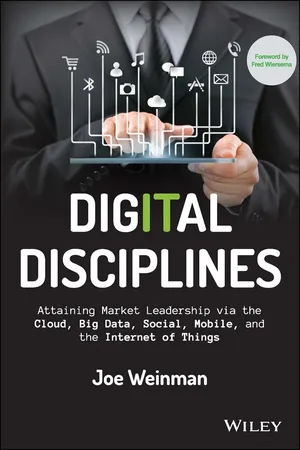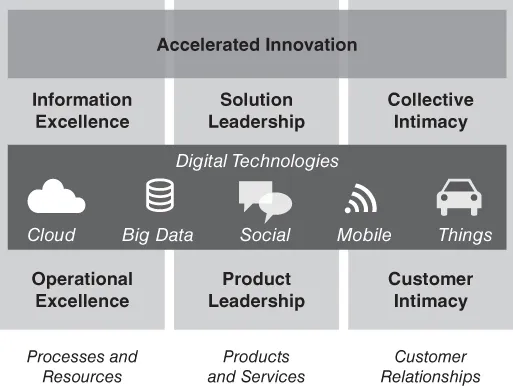
Digital Disciplines
Attaining Market Leadership via the Cloud, Big Data, Social, Mobile, and the Internet of Things
- English
- ePUB (mobile friendly)
- Available on iOS & Android
Digital Disciplines
Attaining Market Leadership via the Cloud, Big Data, Social, Mobile, and the Internet of Things
About this book
Leverage digital technologies to achieve competitive advantage through market-leading processes, products and services, customer relationships, and innovation
How does Information Technology enable competitive advantage? Digital Disciplines details four strategies that exploit today's digital technologies to create unparalleled customer value. Using non-technical language, this book describes the blueprints that any company, large or small, can use to gain or retain market leadership, based on insights derived from examining modern digital giants such as Amazon, Netflix, and Uber, established firms such as Burberry, GE, Nike, and Procter & Gamble, and lesser-known innovators such as Alvio, Fruition Sciences, Opower, and Quirky.
Companies can develop a competitive edge through four digital disciplines—information excellence, solution leadership, collective intimacy, and accelerated innovation—that exploit cloud computing, big data and analytics, mobile and wireline networks, social media, and the Internet of Things. These four disciplines extend and update the value disciplines of operational excellence, product leadership, and customer intimacy originally defined by Michael Treacy and Fred Wiersema in their bestselling business classic The Discipline of Market Leaders.
- Operational excellence must now be complemented by information excellence —leveraging automation, information, analytics, and sophisticated algorithms to make processes faster, better, and more cost-effective, seamlessly fuse digital and physical worlds, and generate new revenue through techniques such as exhaust data monetization
- Product leadership must be extended to solution leadership —smart digital products and services ranging from wind turbines and wearables to connected healthcare, linked to each other, cloud services, social networks, and partner ecosystems, focused on customer outcomes and creating experiences and transformations
- Customer intimacy is evolving to collective intimacy —as face-to-face relationships not only go online, but are collectively analyzed to provide individually targeted recommendations and personalized services ranging from books and movies to patient-specific therapies
- Traditional innovation is no longer enough— accelerated innovation goes beyond open innovation to exploit crowdsourcing, idea markets, innovation networks, challenges, and contest economics to dramatically improve processes, products, and relationships
This book provides a strategy framework, empirical data, case studies, deep insights, and pragmatic steps for any enterprise to follow and attain market leadership in today's digital era. It addresses improved execution through techniques such as gamification, and pitfalls to beware, including cybersecurity, privacy, and unintended consequences.
Digital Disciplines can be exploited by existing firms or start-ups to disrupt established ways of doing business through innovative, digitally enabled value propositions to win in competitive markets in today's digital era.
Frequently asked questions
- Essential is ideal for learners and professionals who enjoy exploring a wide range of subjects. Access the Essential Library with 800,000+ trusted titles and best-sellers across business, personal growth, and the humanities. Includes unlimited reading time and Standard Read Aloud voice.
- Complete: Perfect for advanced learners and researchers needing full, unrestricted access. Unlock 1.4M+ books across hundreds of subjects, including academic and specialized titles. The Complete Plan also includes advanced features like Premium Read Aloud and Research Assistant.
Please note we cannot support devices running on iOS 13 and Android 7 or earlier. Learn more about using the app.
Information
Part One
Overview and Background

Chapter 1
Digital Disciplines, Strategic Supremacy
From Value Disciplines to Digital Disciplines
Table of contents
- Cover
- Title Page
- Copyright
- Table of Contents
- Dedication
- Foreword
- Preface
- Acknowledgments
- Part One: Overview and Background
- Part Two: Information Excellence
- Part Three: Solution Leadership
- Part Four: Collective Intimacy
- Part Five: Accelerated Innovation
- Part Six: Successful Execution
- Part Seven: What's Next?
- About the Author
- Index
- End User License Agreement